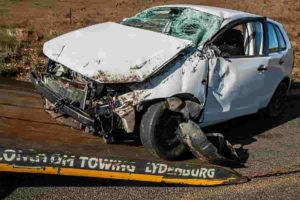The average motorist will be involved in a car accident about once every 18 years. And that risk only becomes greater the more you drive. When the odds aren’t in your favor, the right auto insurance policy not only can protect you against financial loss but also can give you peace of mind knowing you’re covered in the worst-case scenario.
Shopping for car insurance can feel like drinking from a firehose. Between the deductibles, co-pays, premiums, and fine print, it’s easy to get lost and put pen to paper on a policy that doesn’t provide adequate coverage. Fortunately, our Geeks have spent years investigating the ins-and-outs of America’s auto insurance options. In this guide, we’ll walk you through the types of coverage offered by the country’s top insurers.
Read on to arm yourself with an in-depth understanding of types of car insurance coverage:
What Is SR-22 Insurance?
Has your license been revoked or suspended? Bad luck or bad driving can land you in hot water with the law, leaving you to run the gauntlet of exhausting admin required to reclaim your driving privileges. Before your license can be reinstated, you may be required to show an SR-22 form to prove you are adequately covered.
Technically speaking, SR-22 is not a type of insurance. Companies offering SR-22 insurance are advertising that they are able to file the appropriate paperwork to notify the state you are covered. This insurer will also update the state on changes to your policy such as cancellations and renewals. Some insurance providers also offer discounted rates to drivers who need SR-22 insurance.
Remember, if your license was revoked or suspended due to a serious driving offense, the state will require your insurer to provide annual updates on your policy. These offenses can include:
- Drunk driving;
- Reckless driving;
- Driving without insurance;
- Causing a severe crash; or
- Committing numerous traffic violations over a short period of time.

If you miss a payment or cancel your insurance, the insurer will have to report that your coverage has lapsed, and you could lose your driving privileges again.
Buying SR-22 insurance is as simple as checking the right boxes when purchasing your new policy. While most insurers offer SR-22 insurance, you may benefit from opting for a provider who specializes in coverage for high-risk drivers. Take note: Due to the nature of your violation and the state-specific fees associated with filing SR-22 forms, this type of insurance can be expensive.
What Is Collision Coverage?
Getting your vehicle repaired can take a huge bite out of your budget. Collision coverage is your safety net, ensuring that even when an accident is your fault, you won’t break the bank to keep your car on the road.
This optional add-on to a basic policy has become a popular addition for drivers looking to protect their four-wheeled assets. Not only does it cover damage to your car caused in any collision with another vehicle or object, but insurers will also pay for pothole damage and ice and slide damage.
Adding collision coverage to your plan is expensive, but these costs pale in comparison to the average price of repairing or replacing your car.
What Is Comprehensive Coverage?
When Hurricanes Irma and Harvey tore through the U.S., more than 1 million vehicles were damaged or destroyed. When a blaze in California blackened the state’s lush landscapes in 2018, the unstoppable inferno left hundreds of scorched vehicles in its wake. An “act of God” can wipe out your assets in seconds and leave you to pick up the pieces—and the damage probably won’t be covered by your basic policy.
Fortunately, investing in comprehensive coverage can help you weather the elements, paying for any vehicle damage or loss caused by natural disasters, falling objects, fires, theft, riots, and vandalism. Simply put, this addition to your basic policy will cover repair costs related to any vehicle damage that isn’t a collision.
If you lease or finance a vehicle, there’s a good chance your lender will require you to carry a policy that includes comprehensive and collision coverage until the car is paid off or until the lease comes to an end. But if you’ve already paid off your vehicle, you should still consider investing in a comprehensive policy for added peace of mind and financial security.
What Is Uninsured/Underinsured Motorist Coverage?
Before you can use your vehicle on the road, you need to purchase coverage that meets your state’s minimum insurance requirements. Unfortunately, even if you’re covered, about 12 percent of drivers are uninsured.
Uninsured motorist coverage protects you against the road’s risktakers, ensuring that costs related to damage or injuries you have sustained in a collision with an at-fault uninsured or underinsured driver will still be covered even when the other motorist involved does not have the means to do so.
This type of insurance is split into three categories:
Underinsured Motorist Coverage (UIM): Many drivers elect to pay for only the bare minimum coverage mandated by their state. This probably will not be enough to cover the costs of damage and injuries you, your passengers, and your property after a serious collision. Adding UIM coverage to your basic policy will protect you when an at-fault driver’s insurer does not cover all your costs.
Uninsured Motorist Bodily Injury (UMBI) Coverage: If you are involved in a crash with an uninsured driver, this add-on will kick in to cover the costs of injuries sustained by anyone included in your policy, from you and your family members to friends and employees. UMBI may also cover other expenses such as income you have lost while being out of work during recovery.
Uninsured Motorist Property Damage Coverage: This optional extra will cover damage to your vehicle caused by an uninsured driver. If you already plan on carrying collision coverage, our Geeks have concluded that it’s not worth increasing your premium to include the UMPD feature.
UIM, UMBI, and UMPD coverage are relatively inexpensive additions to your basic policy and could benefit you in the long run, particularly if you live in states such as Florida, New Mexico, Michigan, Mississippi, Arkansas, Indiana, Washington, Alabama, Tennessee, and Washington, D.C., where there are a relatively high number of motorists driving without insurance.
What Is Personal Injury Protection?
Even a minor crash can put tremendous stress on your body, causing long-term injuries that require expensive treatment, pain management, and rehabilitation. Personal Injury Protection (PIP) is a popular policy add-on that will help cover the costs of treating injuries sustained in a crash regardless of who is at fault. Unlike MedPay, Personal Injury Protection could also compensate you for lost wages, absorb the steep price of emergency services, cover funeral costs, or reimburse your family for survivor’s loss.
PIP is mandatory in 15 states including Utah, Texas, Pennsylvania, Oregon, North Dakota, New York, New Jersey, Minnesota, Michigan, Massachusetts, Kentucky, Kansas, Hawaii, Florida, and Delaware. However, even in states where PIP is optional, our Geeks highly recommend it because countless families are forced to borrow money, dig into savings, or declare bankruptcy in the aftermath of severe accidents.
When you purchase PIP, you will be offered a choice between a deductible or zero deductible. Remember, the larger your deductible, the lower your premium will be, but the more you will have to fork out if you’re injured in a wreck. Now, if you choose to go with no deductible, most insurers will pay 80% of your hospital bills, safeguarding you from a potentially bankrupting financial loss in the event of a crash.

What Is MedPay?
MedPay is the less-comprehensive cousin of PIP coverage that can pay for medical expenses incurred by you, your family, other drivers listed on your policy, and your passengers. MedPay kicks in regardless of who was at fault, giving you access to a lifeline of funds that will help you shoulder the costs of treating injuries sustained in an accident.
Think of MedPay as a way of bolstering your current PIP policy. It has no co-pay or deductible, pays out quickly, and can even cover injuries sustained as a passenger or pedestrian, whether you’re taking public transportation or riding your bike.
MedPay is mandatory in only two states: New Hampshire and Maine.
What Is Pay-Per-Mile Insurance?
If your car spends more time parked than on the road, you may be the perfect candidate for pay-per-mile insurance. This policy is exactly what it says on the can, giving you access to all the benefits of mandatory coverage at a cost based on the number of miles you’ve driven.
The logic is that the less time a motorist spends on the road, the less likely he or she is to be involved in a crash. Many companies have experimented with offering monitoring devices to motorists designed to track and analyze driving habits and adjusting premiums based on the results. Some insurers have taken this a step further, using the data to record every mile driven and attaching a price to the distance. If you use your vehicle rarely or have a second car reserved for shorter trips, this type of insurance could save you hundreds of dollars every year.
What Is Accident Forgiveness Insurance?
If you are involved in a collision and your insurer determines it was your fault, you’ll probably notice an uptick in your premiums. Accident forgiveness is an optional feature that will safeguard your driving record and insurance premiums from being affected by your insurer’s ratings system after you’ve caused an accident.
However, in most cases, this protection will only apply to your first at-fault accident. Insurers will often include accident forgiveness as part of their basic policy offerings to help “sweeten” the deal. But providers are not likely to offer you this feature if you have past crashes and other road violations in your driving history.
What Is Rental Insurance?
Many insurers will extend the liability coverage included as part of your policy to cars you are renting. Not only will this help you save money in the long run (especially if you travel frequently and have to make use of rental vehicles at your destination), but it can also provide you with more comprehensive coverage than day-to-day policies offered by rental agencies.
What Is Emergency Road Service Coverage?
Even your brand-new car could break down on the highway. Emergency Road Service Coverage will kick in to compensate you for the costs of paying for roadside assistance. This feature typically covers:
- Costs of towing your vehicle to an auto shop;
- Battery services;
- Oil, gas, battery, and tire delivery;
- Tire changes;
- Locksmith services if you are locked out of your car; and
- On-site mechanical labor.
Because Emergency Road Service Coverage is relatively inexpensive, our Geeks recommend adding it to your policy. At most, you can expect to pay just a few extra dollars for peace of mind that your next break down won’t break the bank.
Now that you know about the types of auto insurance coverage available, it’s time to compare the options and find the best policy for your needs. Click here to use our car insurance quote comparison tool.
